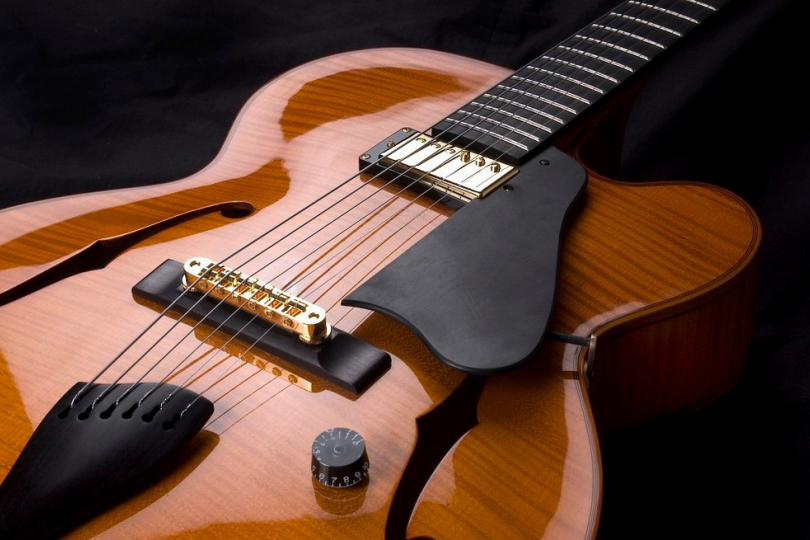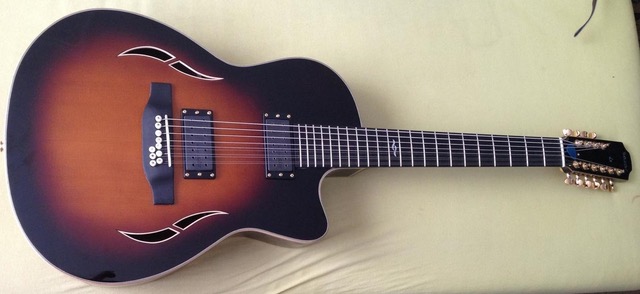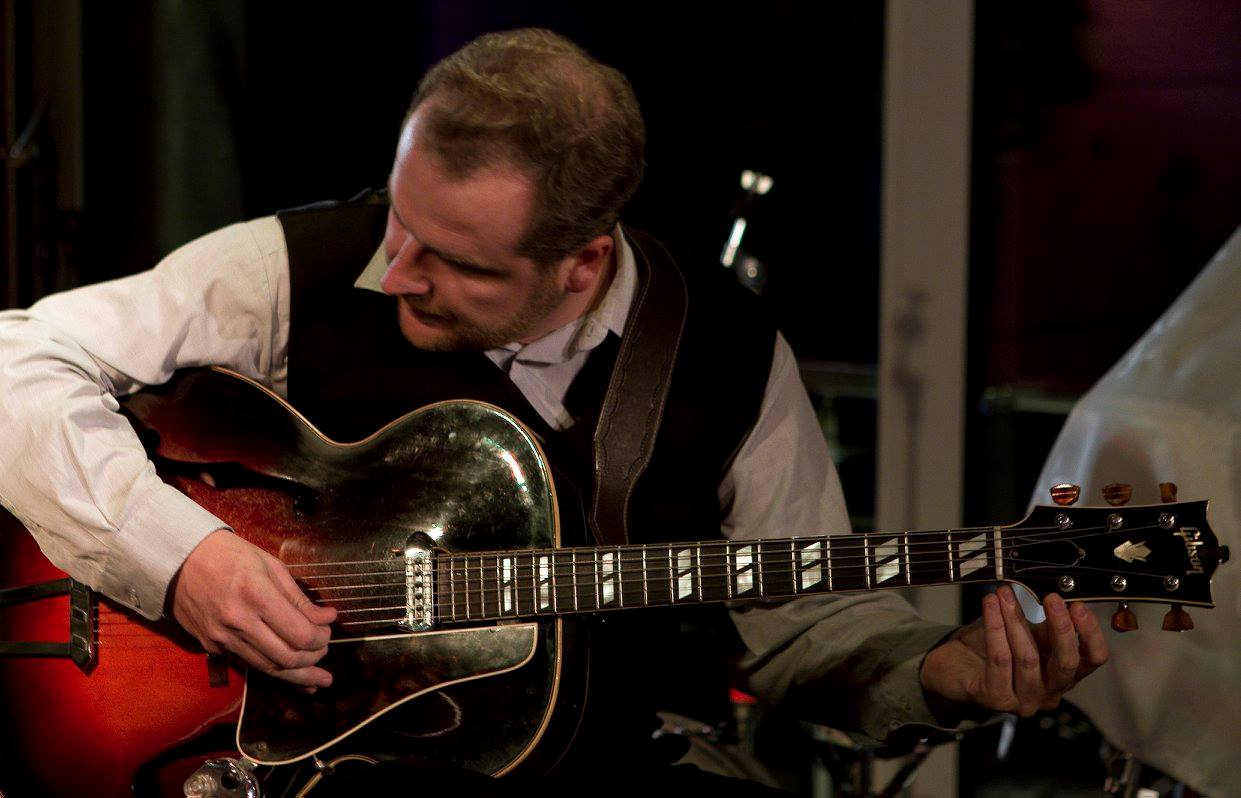
Legendary and Mythical Guitars #10: Procházka Custom Guitars
In the last episode of our series, we will visit my homeland, the Czech Republic. After all, even in this little country, one can find skilled guitar makers whose fame has spread beyond its borders. And since we have not yet written about any specialists in jazz guitars, and certainly not in archtop instruments, we would like to introduce Petr Procházka and his team.
First meeting
Some years ago, my friend Bob and I had a guitar duo. We started out jamming on acoustic guitars in the pub, then switched to Crafter electro-acoustic hybrids to be able to play through the PA at public venues. I had a 6-string instrument, Bob had a 12-string one, on which he also played the bass lines. It was working pretty well, so we decided to break open our piggy banks and upgrade a bit. I kept it simple. I bought a Taylor T5. But Bob's nut was much bigger to crack. He wanted a guitar with single bass strings, ideally enhanced by a lower B, like seven-string guitars have. And to make matters worse, doubled upper strings starting at G to play harmonic accompaniment.
Obviously, you can't just go to a music shop with such a request, you need a specialist. Bob got a tip for Petr Procházka. And he really helped. Our scepticism about this strange commission disappeared when we plugged the guitar into a Roland Jazz Chorus combo and, at the same time, a bass amp. We acquired an eccentric guitar that met our wildest expectations.
Just for the record, the guitar has a spruce top and the sides and back are mahogany. The neck is made of the same material with an ebony fingerboard. There are magnetic pickups by Jan Šlapák and piezo pickups in the bridge, and the ratio of the pickups can be adjusted.

Learning the craft
Petr Procházka was born on 2 October 1972 in Prague. He attended the grammar school Na Zatlance in Prague 5. As we know, one cannot always predict the impact certain situations will have in the future. After graduating from high school, Petr wasn't accepted to university and needed to find another direction in his life – and thus his future destiny started to take shape.
As a high-school student, he played the guitar he got for his 18th birthday. It was made by Josef Kubla, a luthier from Cheb, one of the few people who were allowed to make and sell their own musical instruments during the communist regime in the 1970s. Peter was already very interested in guitar making at that time. And so, under the pretext of repair, he went to the guitar maker.
The visit to the guitar workshop was the turning point that decided Petr's future. He described it this way: "I think that the first visit to the guitar workshop in Cheb was crucial. It was such an incredible, fascinating world that I still remember that first impression when I entered the workshop."
The guitar maker in training sought information wherever he could. Eventually, he became Josef Kubla's student. The teacher made sure that Petr could attend the practical lessons at the Secondary Vocational School of Musical Instrument Makers in his workshop. At that time, the only available publications on guitar-making were the school's textbooks. But even these were slightly outdated and mainly focused on factory production and technology. Details were lacking. The apprentice commuted from Prague to the school and Kubla's workshop and thus gained the first knowledge of his future craft. Not surprisingly, he applied for a trade license in 1995 and officially began building his first instruments as a qualified guitar maker.
An important figure in the development of Petr's know-how was his friend Ladislav Kučera Huberťák, another former pupil of Kubla's, who gave him some priceless advice in the early days and helped him to understand the secrets of instrument making. Also his colleague Jiří Mázl inspired him – in the 1990s, they struggled through the early days of their careers and attended their first exhibitions together.
The meeting with his current colleague, Petr Grötzbach, was crucial for Petr Procházka. After his arrival, the company accelerated the instrument development and professionalised the whole business. Being experienced in the field and knowing many active musicians, Petr Grötzbach managed to arrange the cooperation of guitarists in the development of new models.
Another source of support is guitarist Jaroslav Šindler, a professor at Prague's Ježek Conservatory, who collaborates with Procházka on the electric jazz guitar development – a very specific discipline, even in the world of guitar makers. Marek Rejhon, on the other hand, helped with the gypsy jazz guitar project and is currently working on the design of western guitars.

In the jazz Shangri-La
Over time, Procházka Guitars has established itself as one of the few master workshops that can produce elaborate jazz guitar models, including those with arched tops. And that's indeed a high level of guitar-making. They can also make quality acoustic guitars and solid body electrics, but jazz guitars have become a kind of trademark for the brand and guitarists associate the company's name mostly with this category of instruments.
How are the archtops made? First of all, the top board, usually spruce, must achieve the right degree of internal humidity, which entails sensitive drying over many years. Sure, drying can be accelerated in various ways, but that's not how they do it in Procházka guitars. So it requires stocking a "bank" of good quality material for the top boards well in advance.
In the next step, two wedges are glued together, then the board's shape is cut out and afterwards, the top's profile is shaped (one could say "hollowed out") with special types of planes. Once the top is finished, it is drilled out from the other side to achieve a specific thickness. Then the bottom arch is shaped using chisels and planes. Here, the strength and density of the material must be taken into account. Each raw piece has different properties, with thicknesses ranging from three to seven mm.
Then, the resonance holes are milled. Two longitudinal braces are made and fixed. The builders call this "chalk-fitting", which means that the position of the brace is marked on the bottom of the plate with chalk and then the brace is pressed in such a way that the chalk is imprinted along its entire length. Then the brace is glued. The back plate follows a very similar procedure, but it has no bracing.
The difference between a flat and an arched top is quite fundamental. It means a different bridge and also different string tension on the soundboard. Therefore, the resonance of the guitar is not the same at all. Good jazz guitars have a punchy sound and can easily assert themselves when playing with other instruments.

What does the standard model look like?
Procházka Guitars has enough orders to operate as a pure custom shop. When I asked the makers what their stock model would look like if they decided to expand production one day, after a short reflection, we came up with some general features that they tend to rely on.
As we have already said, jazz acoustic and semi-acoustic guitars are characteristic of Procházka Custom Guitars, so I was particularly interested in these kinds of instruments and their typical representatives. Petr Grötzbach described it like this:
- Our concept of a proper jazz guitar is based on the pre-war Gibson L5 and L4 models. These are "swing" models with 16 or 17-inch bodies.
- The top is made of 4A spruce, hand carved, the back is made of flamed maple, again hand carved, and the sides are made of the same material.
- There is also a three-piece maple neck with an ebony fingerboard. The bridge is also made of ebony.
- The strings are mounted on a "retro" tailpiece, there is a bone nut and the tuners are from Grover or Schaller.
- Such a model would be factory-fitted with Thomastik 13-strings.
Other identifying features of Procházka guitars
What else is typical of Procházka guitars? For example, necks of both jazz and acoustic guitars are always connected to the body with the dovetail joint. As for the bracing, they use their version of the X pattern. In the case of jazz guitars, they also employ the so-called parallel bracing developed by Lloyd Loar. He was a musician and luthier who made history in the first half of the 20th century with many innovations in the development and production of not only guitars but also mandolins. At Gibson, he was responsible for the famous L5 models from 1922. It was a reaction to the swing big band era and until 1940, they were purely acoustic instruments. Incidentally, it was the world's first guitar with "f" shaped cut-outs.
But let's get back from Kalamazoo to Prague and let's find out about the lacquers. As for these, Procházka isn't too picky. He uses nitro lacquers, of course, but also oil lacquers (a traditional finish on Gibson in the 1920s and 1930s) and sometimes even the sophisticated alcohol polishes typically found on classical concert guitars.
If you don't want just an acoustic instrument and wish to amplify the sound, you can customise the pickup to your liking. And if you don't know, they'll suggest Gibson, DeArmond, Benedetto or Kent Armstrong pickups depending on the type of instrument.

Customised guitar menu
How to get a Procházka guitar? For the time being, you can only order one after personal consultation with the producer. Due to the rather specific production program, the workshop carefully monitors the accuracy of the customer's order. The manufacturer wants to understand perfectly the instrument's purpose and consult possible variants with the client to achieve the best possible result so that the instrument fulfils its musical destiny.
For better customer orientation, there is a catalogue that helps prospective buyers set their specifications. There you can find typical models as well as detailed technical specification items, which help to define the customer's vision of their dream guitar.
All solid wood instruments can be purchased for under 4000 euros, but the final price corresponds to the client's requirements regarding the type, basic materials, hardware and sound system.

Who plays Procházka guitars?
In whose hands can we find Procházka guitars? We have already mentioned Professor Jaroslav Šindler. Another prominent jazz teacher who plays them is Professor Christian Havel of the Jam Music Lab at the Private University for Jazz and Popular Music in Vienna. We can also mention accomplished jazz expert Jaroslav Kantor, former guitarist of the Czech Radio Big Band, as well as other jazz stars, such as Vilém Spilka or Petr Zeman. Worldwide, a Procházka instrument is owned, for example, by Christian Rover, a German-born and globally successful jazz virtuoso.

To conclude
Traditional manufacturing techniques, no artificial acceleration when it comes to the maturity of materials, consistent and precise craftsmanship and a focus outside the musical mainstream. These are the main characteristics of Petr Procházka's mini-factory in Prague.
Let this be proof that there are guitar makers in this small country who can successfully compete with the outside world. In our series, we couldn't possibly mention all the interesting guitar makers out there, however, guitar fans probably know many of them from other sources or will get to know them sooner or later. The guitar business is, after all, a rather small and self-contained world, where everyone eventually meets everyone else if they are sincerely interested in these noble instruments.
If you have found an error or typo in the article, please let us know by e-mail info@insounder.org.





